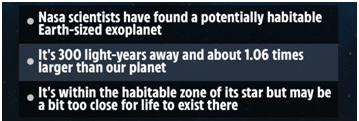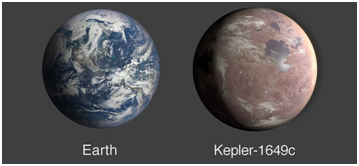PREVIOUS
New Exoplanet
April 23 , 2020
1821 days
1102
0
- A group of Scientists from NASA discovered a planet called Kepler-1649c.
- It is orbiting in its star's (red dwarf star Kepler-1649) habitable zone.
- The habitable zone is the area around a star where a rocky planet could support liquid water.
- It is located 300 light-years from Earth.
- It is most similar to Earth in size and estimated temperature.
- This newly revealed world is only 1.06 times larger than our own planet.
- Also, the amount of starlight it receives from its host star is 75% of the amount of light Earth receives from our Sun.
- It means the exoplanet's temperature may be similar to our planet's as well.
- But unlike Earth, it orbits a red dwarf.

- A year on Kepler-1649c is equivalent to only 19.5 Earth days.
- This type of star is known for stellar flare-ups that may make a planet's environment challenging for any potential life.
- This gives us even greater hope that a second Earth lies among the stars, waiting to be found.
- The data gathered by missions like Kepler and Transiting Exoplanet Survey Satellite [TESS] will continue to yield amazing discoveries.
- There are other exoplanets estimated to be closer to Earth in size such as TRAPPIST-1f and Teegarden c.
- Others may be closer to Earth in temperature, such as TRAPPIST-1d and TOI 700d.
- But there is no other exoplanet that is considered to be closer to Earth in both of these values that also lies in the habitable zone of its system.
- The Kepler space telescope is a retired space telescope launched by NASA to discover.
- Named after astronomer Johannes Kepler, the spacecraft was launched in 2009 into an Earth-trailing heliocentric orbit.
- NASA announced its retirement in 2018.
- It was designed to survey a portion of Earth's region of the Milky Way to discover Earth-size exoplanets in or near habitable zones.
- It was to estimate how many of the billions of stars in the Milky Way have such planets.

Leave a Reply
Your Comment is awaiting moderation.


